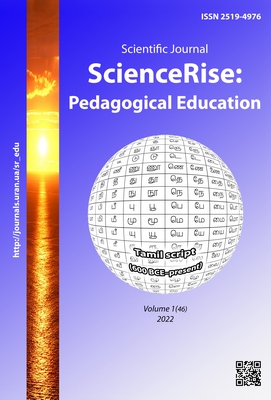Investigation of the awareness of rural students on M-learning using smartphones
DOI:
https://doi.org/10.15587/2519-4984.2022.252875Keywords:
awareness, M-learning, smartphones, Smartphone Questionnaire (SQ), South African rural higher institution students (SARHIS)Abstract
The outbreak of the COVID-19 pandemic has led to a sudden transition from face to face to online teaching and learning practices in various parts of the world. Meanwhile, the level of awareness and adoption of mobile learning (M-learning) by means of smartphones in many rural parts of Africa tends to be considered low. The reasons for this include various factors, such as poor access to internet facilities, a lack of funds, the cost of smartphones, amongst others. This study investigates the level of awareness of South African rural higher institution students (SARHISs) on M-learning using smartphones. A quantitative method was adopted for the study. Convenience sampling was used to select the institution and the 75 respondents who took part in the study. Data were collected by means of a questionnaire, entitled “Smartphone questionnaire (SQ)”. The collected data were analysed using the Statistical Package for the Social Sciences (SPSS), Version 25. The findings of the study show that the adoption of M-learning using smartphones by the respondents who are students from the South African Rural Higher Institution (SARHIS) is moderate – a little above the average. Based on the study, it is recommended, that students’ awareness should be raised and that M-learning should be supported given the recent transition from onsite to online teaching and learning practices
References
- Ghavifekr, S., Rosdy, W. A. W. (2015). Teaching and Learning with Technology: Effectiveness of ICT Integration in Schools. International Journal of Research in Education and Science, 1 (2), 175–191. doi: http://doi.org/10.21890/ijres.23596
- Sutherland, C. (2020). 7 Reasons why Students Need Technology in the Classroom. Explorance. Available at: https://explorance.com/blog/7-reasons-students-need-technology-classroom/
- Gordon, S. (2021). How Smartphones Create Distractions in the Classroom. VerywellFamily. Available at: https://www.verywellfamily.com/how-smartphones-are-creating-distractions-in-the-classroom-4174646
- Smartphones in Education: Redirecting Distraction (2020). ViewSonic. Library. Available at: https://www.viewsonic.com/library/education/smartphones-in-education-redirecting-distraction/
- Chisango, G., Marongwe, N. (2021). The digital divide at three disadvantaged secondary schools in Gauteng, South Africa. Journal of Education, 82, 149–165. doi: http://doi.org/10.17159/2520-9868/i82a09
- Helton, D. (2016). A framework for smartphones in rural Africa. Journal of International Business and Economics, 16 (3), 47–56. doi: http://doi.org/10.18374/jibe-16-3.5
- Jacob, B. A. (2016). The opportunities and challenges of digital learning. Brookings. Available at: https://www.brookings.edu/research/the-opportunities-and-challenges-of-digital-learning/
- Marongwe, N., Munienge, M., Chisango, G. (2019). Can a solution be found using information and communication technology gadgets in higher education? A case of a rural university. Paper presented at EDULEARN19, 11th International Conference on Education and New Learning Technologies. Palma. doi: http://doi.org/10.21125/edulearn.2019.0344
- Muthuprasad, T., Aiswarya, S., Aditya, K. S., Jha, G. K. (2021). Students’ perception and preference for online education in India during COVID -19 pandemic. Social Sciences & Humanities Open, 3 (1). doi: http://doi.org/10.1016/j.ssaho.2020.100101
- Lederman, D. (2020). The Shift to Remote Learning: The Human Element. Inside Higher Ed. Available at: https://www.insidehighered.com/digital-learning/article/2020/03/25/how-shift-remote-learning-might-affect-students-instructors-and
- The History of Education: 1658 to present (2011). South African History Online. Available at: http://www.sahistory.org.za/topic/amersfoort-legacy-timeline-1658-present
- Mosweunyane, D. (2013). The African Educational Evolution: From Traditional Training to Formal Education. Higher Education Studies, 3 (4), 53–59. doi: http://doi.org/10.5539/hes.v3n4p50
- Dumbrajs, S., de Jager, T., Bergström-Nyberg, S. (2013). 9th Grade Students Looking at their Chemistry Studies. Comparison between Finland and South Africa. Procedia – Social and Behavioral Sciences, 89, 40–48. doi: http://doi.org/10.1016/j.sbspro.2013.08.806
- Bagarukayo, E., Kalema, B. (2015). Evaluation of eLearning usage in South African Universities: A Critical Review. International Journal of Education and Development using Information and Communication Technology, 11 (2), 168–183.
- Maarman, G. J., Lamont-Mbawuli, K. (2017). A review of challenges in South African education and possible ways to improve educational outcome as suggested by decades of research. Africa Education Review, 14 (3-4), 263–289. doi: http://doi.org/10.1080/18146627.2017.1321962
- Mohamed, S. (2020). South Africa: Broken and unequal education perpetuating poverty and inequality. Amnesty International. Available at: https://www.amnesty.org/en/latest/news/2020/02/south-africa-broken-and-unequal-education-perpetuating-poverty-and-inequality/
- Kraak, A., Hall, G. (1999). Transforming further education and training in South Africa. Pretoria: HSRC, 272.
- Driscoll, M. Education in the 21st Century. Think Strategic. Available at: https://thinkstrategicforschools.com/education-21st-century/
- Rugbeer, H. (2005). A Conceptual Framework for Implementing E-Education in Kwazulu-Natal. University of Zululand.
- Tedman, R., Tedman, D. (2007). Introduction to the Evolution of Teaching and Learning Paradigms. Evolution of Teaching and Learning Paradigms in Intelligent Environment, 1–6. doi: http://doi.org/10.1007/978-3-540-71974-8_1
- Mayes, R., Natividad, G., Spector, J. (2015). Challenges for Educational Technologists in the 21st Century. Education Sciences, 5 (3), 221–237. doi: http://doi.org/10.3390/educsci5030221
- Creswell, J. W. (2014). Research Design: Qualitative, Quantitative and Mixed Methods Approaches. Thousand Oaks: Sage.
- Kumar, R. (2019). Research Methodology: A Step by Step Guide for Beginners. London: SAGE.
- Sello, M. (2012). Smartphones and Regular Cellular Phones: Assessing their Impact on Students’ Education at the University of Zululand. University of Zululand, 114.
- Kamboya, M. (2017). The Impact of Smartphone as Learning Tool among Honours Students in the University of Kwazulu-Natal Westville Campus. University of KwaZulu-Natal.
Downloads
Published
How to Cite
Issue
Section
License
Copyright (c) 2022 Chinaza Uleanya, Samuel O. Taiwo, Ayansola O. Ayandibu

This work is licensed under a Creative Commons Attribution 4.0 International License.
Our journal abides by the Creative Commons CC BY copyright rights and permissions for open access journals.
Authors, who are published in this journal, agree to the following conditions:
1. The authors reserve the right to authorship of the work and pass the first publication right of this work to the journal under the terms of a Creative Commons CC BY, which allows others to freely distribute the published research with the obligatory reference to the authors of the original work and the first publication of the work in this journal.
2. The authors have the right to conclude separate supplement agreements that relate to non-exclusive work distribution in the form in which it has been published by the journal (for example, to upload the work to the online storage of the journal or publish it as part of a monograph), provided that the reference to the first publication of the work in this journal is included.








